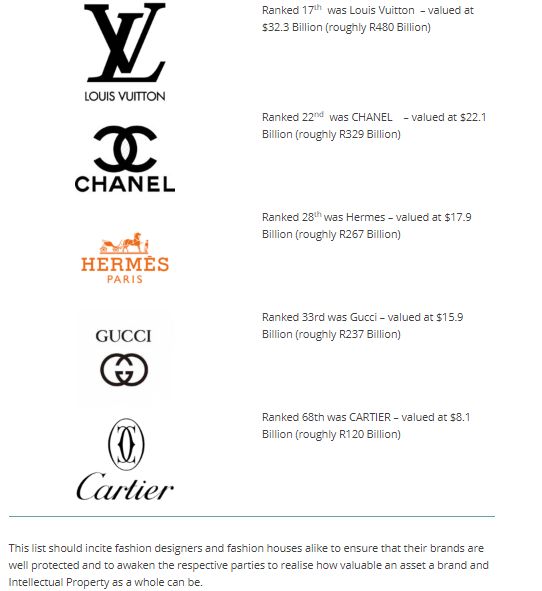Gucci, Versace, Prada, Valentino, Fendi... These are among some of the most elite and luxurious fashion brands in the world. They are brands which have been strategically exploited and brands which have been turned into gold mine assets for their respective fashion houses.
In a constantly changing and developing industry such as fashion, educating oneself in IP is of utmost importance, not only to protect your business but to ensure that one has legal recourse should it become necessary.
This article explores the different IP protection strategies available in fashion. A subsequent article will explore the different ways that a brand can be effectively commercially exploited.
Trade marks
Trade mark protection in fashion covers marks including brand names, logos, shapes, configuration, patterns, ornamentation and / or colours. Through an application process, statutory protection at the relevant Trade Mark Registries can be obtained. In SA, statutory protection can be obtained in perpetuity, subject to the renewal of the mark every 10 years. In essence, a trade mark gives a proprietor the ability to prevent another person from using a brand that could be considered to be the same or similar to the protected brand, forever, should the brand owner choose.
By way of illustration of how important a brand can be, we have set out a list issued in 2019 by Interbrand, a global brand consultancy company, which revealed the Top 100 highest valued brands for the year. The three key indicators that determine the brand value include: the financial performance of the branded products or services, the role of brand in the purchase decision process and the strength of the brand. We have honed in on the Top 5 highest valued luxury fashion brands.

Copyright
In fashion, subject to certain conditions being met, Copyright may subsist in drawings of garments, patterns, designs and/ or photographs that may be taken of fashion pieces, websites, brochures, etc. This list is not exhaustive. In SA, Copyright comes into existence automatically and does not need to be registered. In the USA however, to obtain protection, Copyright is required to be registered.
It is also worth noting that where a designer is, for example, commissioned to design a specific garment and that designer is compensated for the design, ownership of the Copyright that may subsist in that drawing and / or artistic work may not transfer automatically. This appears to be a common misconception in so far as Copyright Law is concerned. An assignment agreement, signed by the relevant parties, is the most secure and advisable manner to ensure that Copyright is transferred from the designer to the commissioner of the work.
Design
Two forms of design protection are available to fashion designers and/ or fashion houses. The first is an aesthetic design, which involves the look and feel of the design, including the patterns, shapes, configurations or ornamentation thereof. The second is a functional design, which involves, broadly speaking, a design applied to an item which has a feature which has been arranged to perform a specific function.
It is possible to pursue several types of IP protection simultaneously. An example of this would be filing a design application, while at the same time, pursuing trade mark protection for a qualifying device, shape, etc. The reason for considering this type of approach would be that the trade mark application process is lengthy and can take up to 3 years to complete, while the design application process is completed much quicker. Protection for a design would be obtained for a period of 10 years (aesthetic design) and 15 years (functional design), after which time trade mark protection could be enjoyed in perpetuity.
Patents
Patent protection speaks to an invention, usually created as a solution to a specific problem. Subject to meeting the necessary requirements, which include that the creation is required to be novel and inventive, patent protection could be pursued in the fashion industry.
By way of example, Nike filed a patent application in the US for its NIKE AIRZOOM ALPHAFLY shoe, which is described to be "a bouncy shoe that makes for faster running, because of the new technology in the shoe".
Conclusion
As an established or up and coming fashion designer or fashion house, starting a trend does not really count for much if the next person will be able to copy and use what you have created and developed without any consequence. Actively ensuring that your IP rights are in place and well protected will not only ensure security for your business and corporate identity, but will fend off 'copycats' from riding on the coattails of your success.
The content of this article is intended to provide a general guide to the subject matter. Specialist advice should be sought about your specific circumstances.


